6-3 Tectonics and volcanism influence surface features
Whereas the Moon and Mercury look similar from a distance, Venus and Mars appear radically different, as shown in Figure 6-9. Venus is nearly the size of Earth and has a thick atmosphere, while Mars is much smaller and has only a thin atmosphere. Yet spacecraft observations reveal that these two worlds have many surface features in common, including volcanoes and impact craters.
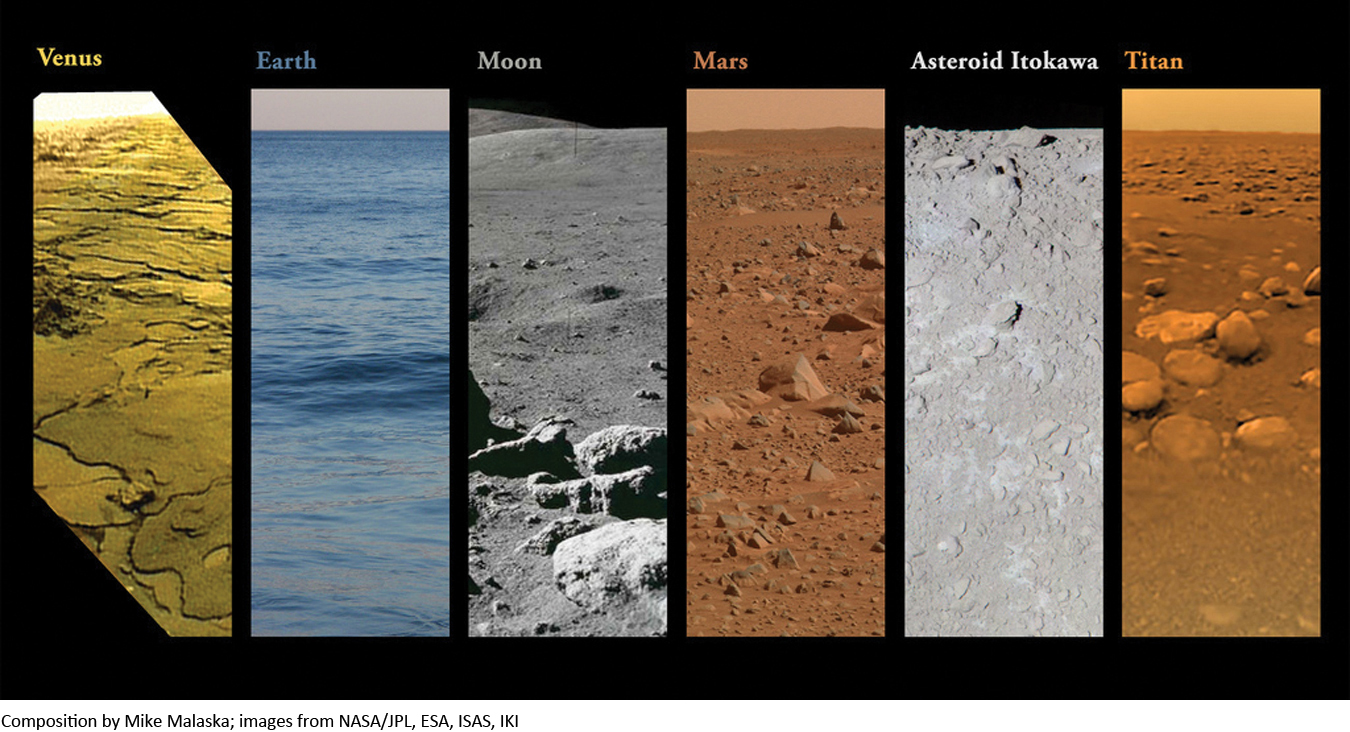
Scientists use orbiting spacecraft to map planets in great detail. To make a detailed study of a planet’s surface, a spacecraft that simply flies by the planet and takes a few digital photographs does not provide enough information. Instead, it is necessary to place a spacecraft in long-term orbit around the planet. Since the 1970s, a number of spacecraft have been placed in orbit around Venus and Mars, yielding amazingly detailed information about their surfaces. Once a detailed surface map is made, inferences about the nature of deep planetary interiors can then be proposed.
In order to map the surface of Venus through the perpetual cloud layer, several of the Venus orbiters carried radar devices. A beam of microwave radiation from the orbiter easily penetrated Venus’s clouds and reflected off the planet’s surface; a receiver on the orbiter then detected the reflected beam. Different types of terrain reflect microwaves more or less efficiently, so astronomers have been able to construct a map of the Venusian surface by analyzing the reflected radiation.
Magellan, the most recent spacecraft to orbit Venus, also carried a radar altimeter that bounced microwaves directly off the ground beneath the spacecraft. By measuring the time delay of the reflected waves, astronomers could determine the height and depth of Venus’s terrain.
By contrast, a Mars orbiter can use a more conventional telescope to view the Martian surface through that planet’s thin atmosphere. Instead of using a radar altimeter to map surface elevations, the Mars Global Surveyor spacecraft (which entered Mars orbit in 1997) used a laser beam for the same purpose.
148
Figure 6-10 and Figure 6-11 are topographic maps of Venus and Mars derived using radar and laser altimeters, respectively. (Note that the scale of these two maps is different: The diameter of Mars is only 56% as large as the diameter of Venus.) The topographies of both worlds differ in important ways from that of Earth. Our planet has two broad classes of terrain: About 71% of the surface is oceanic crust, and about 27% is continental crust that rises above the ocean floors by about 2.5 mi to 4 mi on average. On Venus, by contrast, about 60% of the terrain lies within 600 ft of the average elevation, with only a few localized highlands (shown in yellow and red in Figure 6-10). Mars is different from both Earth and Venus: Rather than having continents scattered among low-lying ocean floors, all of the high terrain on Mars (shown in red and orange in Figure 6-11) is in the southern hemisphere. Hence, planetary scientists refer to Mars as having northern lowlands and southern highlands.
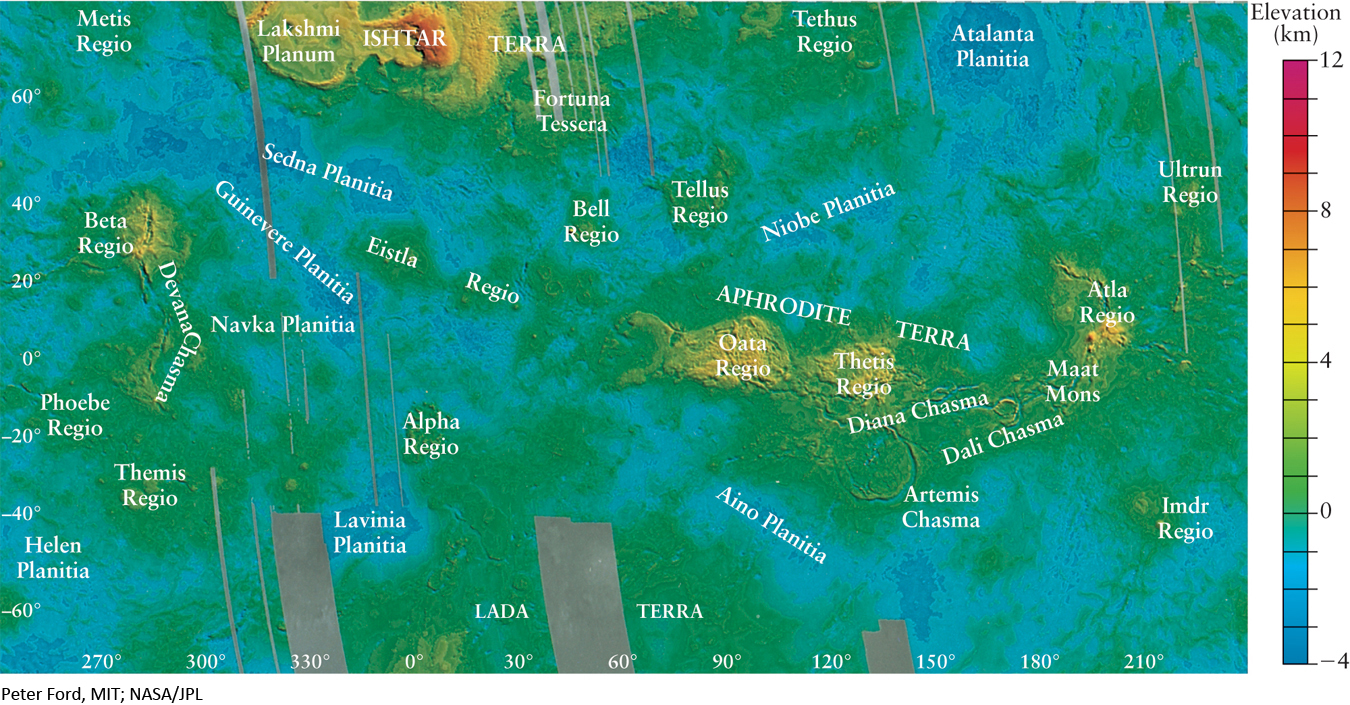
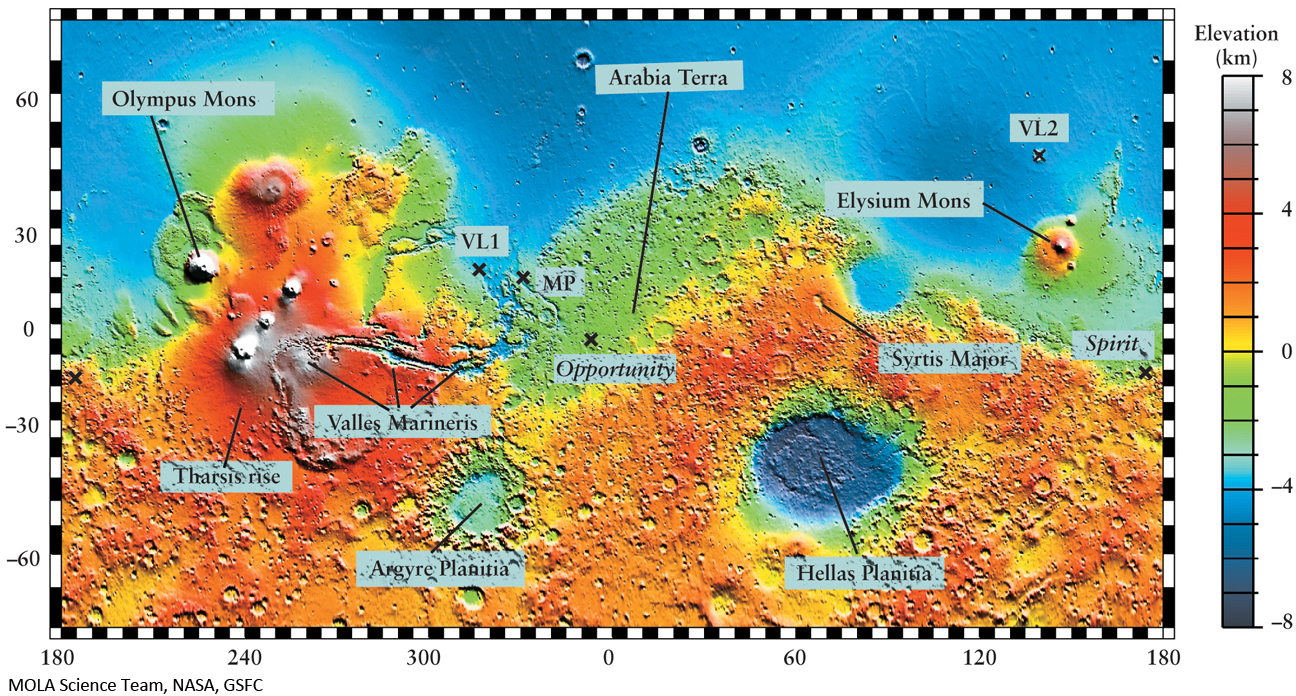
Tectonics on Venus: A Thin Crust
Whereas Mars seems to have a relatively thick crust, Venus has a relatively thin crust. Before radar maps like Figure 6-10 were available, scientists wondered whether Venus had plate tectonics like those that have remolded the face of Earth. Venus is only slightly smaller than Earth and should have retained enough heat to sustain a molten interior and the convection currents that drive tectonic activity on Earth. If this were the case, then the same tectonic effects might also have shaped the surface of Venus. Earth’s hard outermost layer is broken into about a dozen large plates that slowly shuffle across the globe (see Figure 5-18).
149
Radar images from Magellan show no evidence of Earthlike tectonics on Venus. On Earth, long chains of volcanic mountains (like the Cascades in North America or the Andes in South America) form along plate boundaries where subduction is taking place. Mountainous features on Venus, by contrast, do not appear in chains. There are also no structures like Earth’s Mid-Atlantic Ridge (see Figure 5-16), which suggests that there are no places where Venus’s surface is tectonically spreading apart, such as occurs on Earth. With no converging or spreading tectonic plates, there can have been only limited horizontal changes of Venus’s lithosphere. Thus, like the crusts of the Moon and Mercury, Venus’s crust is composed of only one plate.
Unlike the Moon, however, Venus has had some dramatic, but localized, small-scale deformations and reshaping of the surface. One piece of evidence for this is that roughly one-fifth of Venus’s surface is covered by folded and faulted ridges. Further evidence comes from close-up Magellan images, which show that Venus has about a thousand craters larger than a few kilometers in diameter, many more than have been found on Earth, but as noted, only a small fraction of the number on the Moon or Mercury. The number of craters on Venus indicates that the Venusian surface is roughly 500 million years old. This is about twice the age of Earth’s surface but much younger than the surfaces of the Moon or Mercury, each of which is billions of years old. No doubt Venus was more heavily cratered in its youth, but localized activity in its crust has erased the older craters (Figure 6-12).

Surprisingly, Venus’s craters are uniformly scattered across the planet’s surface. We would expect that older regions on the surface—which have been exposed to bombardment for a longer time—would be more heavily cratered, while younger regions would be relatively free of craters. For example, the ancient highlands on the Moon are much more heavily cratered than the younger and smoother dark surfaces. Because such variations are not found on Venus, scientists conclude that the entire surface of the planet has essentially the same age. This is very different from Earth, where geological formations of widely different ages are found.
One model that can explain these features suggests that the convection currents in Venus’s interior are actually more vigorous than those inside Earth, but that the Venusian crust is much thinner than the continental crust on Earth. Rather than sliding around like the plates of Earth’s crust, the thin Venusian crust stays in roughly the same place but undergoes wrinkling and flaking (Figure 6-13). Thus, this model is informally known as “flake tectonics.” As it turns out, Earth also might have had a short period of flake tectonics billions of years ago when its interior was hotter.
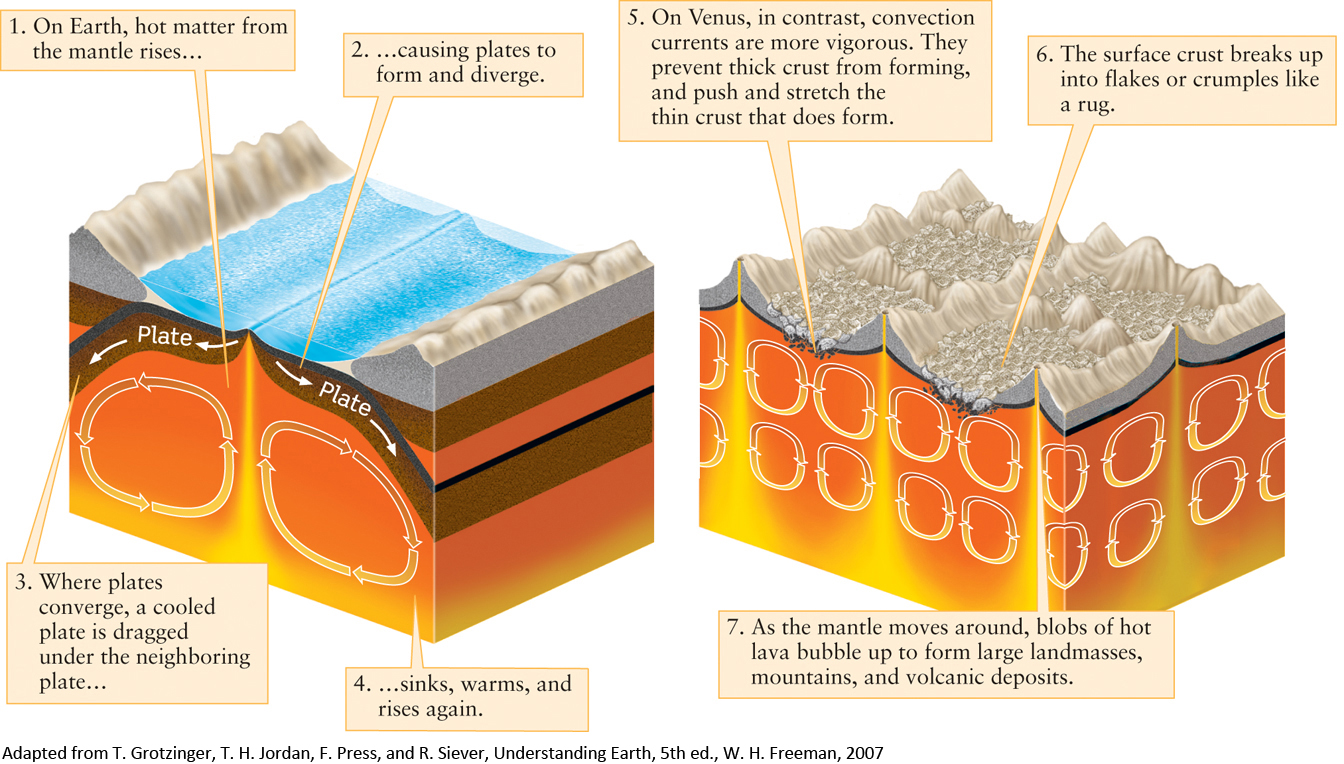
Question
ConceptCheck 6-6: What does the absence of mountain chains on Venus’s surface suggest about the number of plates that cover its surface?
Tectonics on Mars: A Thick, Rigid Crust
Like Venus, Mars lacks the global network of ridges and subduction zones that are evidence of active plate tectonics and a molten interior on Earth. Hence, the entire crust of Mars makes up a single tectonic plate, as is the case on the Moon, Mercury, and Venus. The specific explanation, however, is quite different from that for Venus. Because Mars is a much smaller world than Earth or Venus, the outer layers of the red planet have cooled more extensively. Thus, Mars lacks plate tectonics because its crust is too thick for one part of the crust to be subducted beneath another. We see that for a terrestrial planet to have plate tectonics, the crust must not be too thin (like Venus) or too thick (like Mars), but just right (like Earth).
Active tectonic processes continue to resurface the landscape only if the planet or moon still has a hot, molten interior.
Although there is no plate motion on Mars, there are features on the planet’s surface that indicate there was once substantial motion of material in the Martian mantle. The region scattered with giant volcanoes, known as the Tharsis rise, visible in Figure 6-11, is a dome-shaped bulge that has been lifted 16,000 ft to 20,000 ft above Mars’s average elevation. Apparently, a massive plume of magma once welled upward from a very deep chamber of molten material underlying this region. East of the Tharsis rise, a vast chasm runs roughly parallel to the Martian equator (Figure 6-14). If this canyon were located on Earth, it would stretch from Los Angeles to New York. In honor of the Mariner 9 spacecraft that first revealed its presence in 1971, this chasm has been named Valles Marineris.
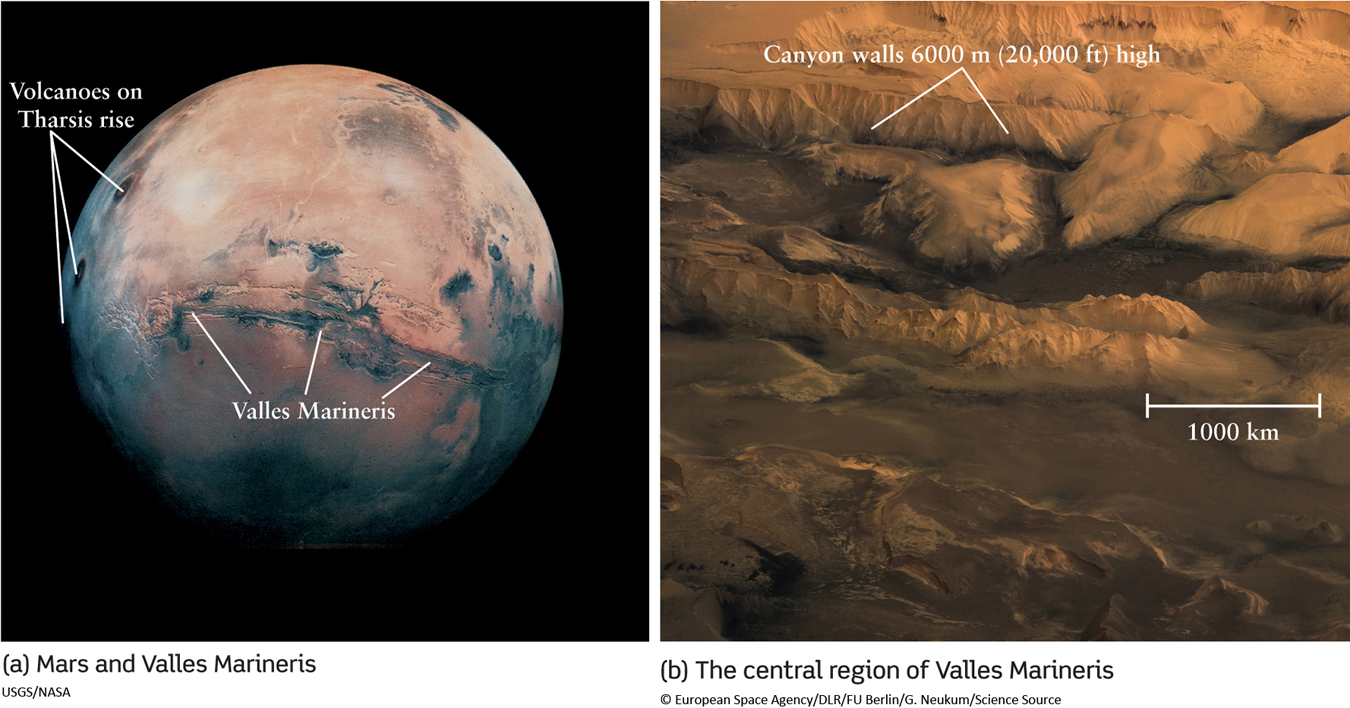
150
Valles Marineris has heavily fractured terrain at its western end near the Tharsis rise. At its eastern end, by contrast, it is dominated by ancient cratered terrain. Many geologists suspect that Valles Marineris was caused by the same upwelling of material that formed the Tharsis rise. As the Martian surface bulged upward at Tharsis, there would have been tremendous stresses on the crust, which would have caused extensive fracturing. Thus, Valles Marineris may be a rift valley, a feature created when a planet’s crust breaks apart along a fault line. Rift valleys are found on Earth; two examples are the Red Sea (see Figure 5-18) and the Rhine River valley in Europe. Other, smaller rifts in the Martian crust are found all around the Tharsis rise. All of these features are very old, however, and it is thought that there has been little geologic activity on Mars for billions of years.
 Go to Video 6-3
Go to Video 6-3
Additional evidence that may point to ancient geologic activity on Mars is the crustal dichotomy between the northern lowlands and the southern highlands. The southern highlands are much more heavily cratered than either Earth or Venus, though less so than the Moon, while the northern lowlands are remarkably smooth and free of craters. (You can see this difference in Figure 6-11.) Since most cratering occurred early in the history of the solar system, this implies that the northern lowlands are relatively young, while the more heavily cratered southern highlands are relatively old. One proposed explanation is that older craters in the northern lowlands were erased by tectonic activity that took place long ago when the Martian crust had not yet cooled to its present thickness.
151
Question
ConceptCheck 6-7: What is the primary implication of Mars having plates that are significantly thicker than those of Earth or Venus?
Volcanoes on Venus and Mars
Radar images of Venus and visible-light images of Mars show that both planets have a number of large volcanoes (Figure 6-15). The Venus-orbiting Magellan spacecraft observed more than 1600 major volcanoes and volcanic features on Venus, two of which are shown in Figure 6-15a. Both of these volcanoes have gently sloping sides. A volcano with this characteristic is called a shield volcano, because in profile it resembles an ancient Greek warrior’s shield lying on the ground. Martian volcanoes are less numerous than those on Venus, but they are also shield volcanoes; the largest of these, Olympus Mons, is the largest volcano in the solar system (Figure 6-15b). Olympus Mons rises nearly 79,000 ft (15 mi or 24 km) above the surrounding plains. By comparison, the highest volcano on Earth, Mauna Loa in the Hawaiian Islands, has a summit only 33,000 ft (9.750 km) above the surrounding Pacific Ocean floor.
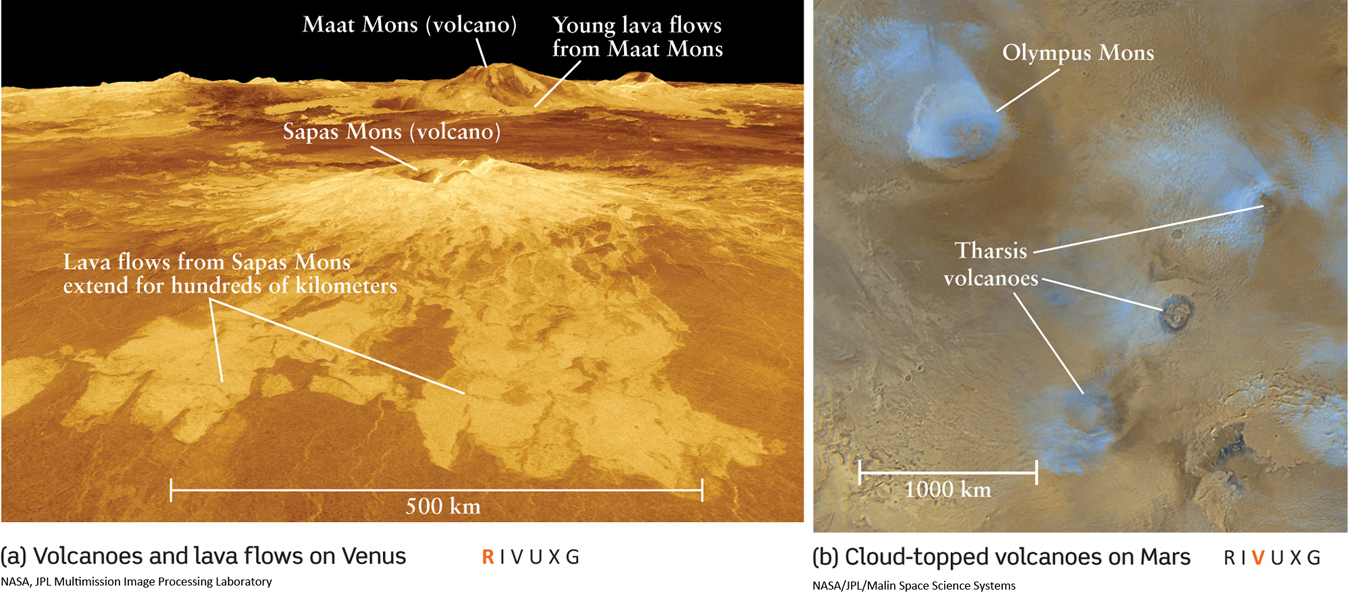
Most volcanoes on Earth are found near the boundaries of tectonic plates, where subducted material becomes molten magma and rises upward to erupt from the surface. This cannot explain the volcanoes of Venus and Mars, since there are no subduction zones on those planets. Instead, Venusian and Martian volcanoes probably formed by magma welling upward from a hot spot in a planet’s mantle, elevating the overlying surface and producing a shield volcano.
On Earth, hot-spot volcanism is the origin of the Hawaiian Islands. These islands are part of a long chain of shield volcanoes that formed in the middle of the Pacific tectonic plate as that plate moved over a long-lived hot spot (Figure 6-16). On Venus and Mars, by contrast, the absence of plate tectonics means that the crust remains stationary over a hot spot. On Mars, a single hot spot under Olympus Mons probably pumped magma upward through the same vent for millions of years, producing one giant volcano rather than a long chain of smaller ones. The Tharsis rise and its volcanoes (see Figure 6-11, Figure 6-14a, and Figure 6-15b) may have formed from the same hot spot that gave rise to Olympus Mons. The same process of hot-spot volcanism presumably gave rise to large shield volcanoes on Venus like those shown in Figure 6-15a.
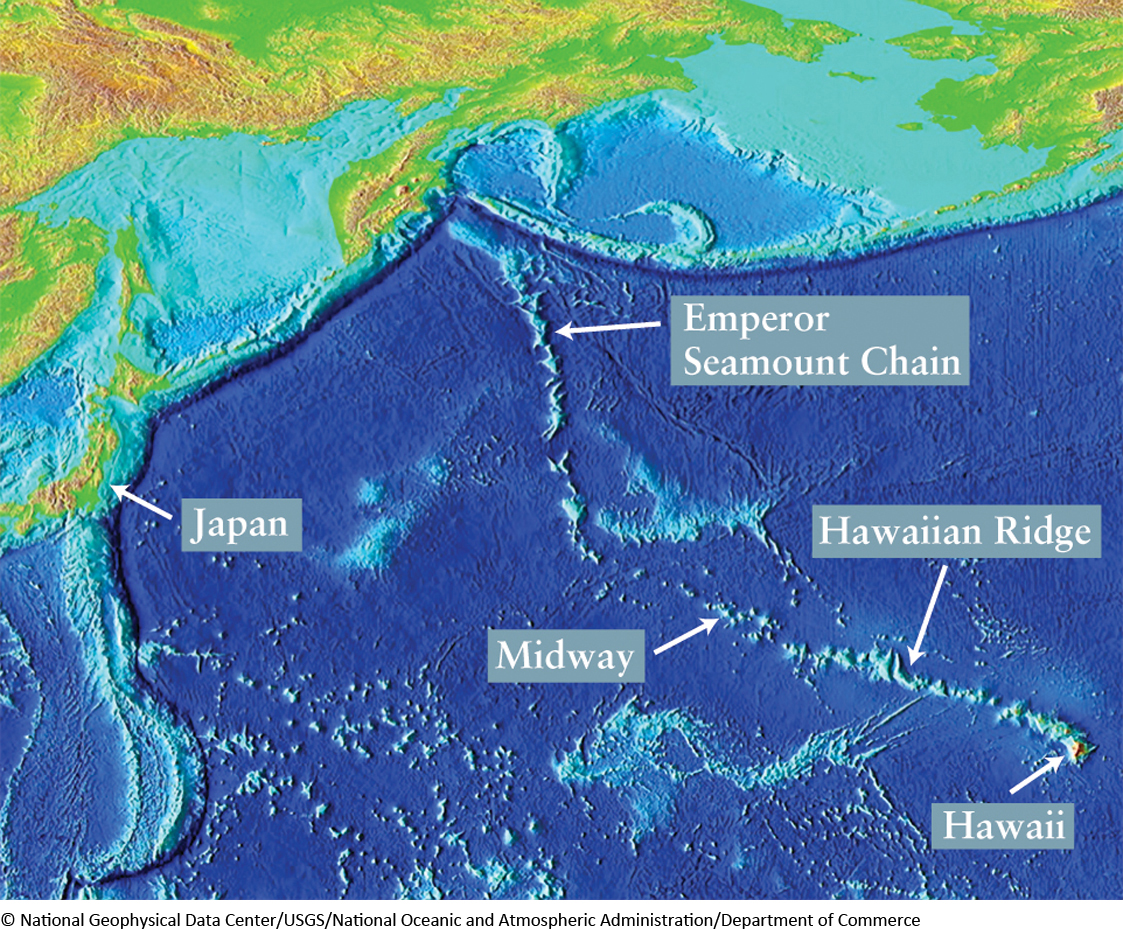
152
THE HEAVENS ON EARTH
Jupiter’s Moon Io Is Covered with Active Volcanoes
If active volcanoes are seemingly absent from the inner planets and their moons, other than Earth, one wonders if there are volcanoes anywhere else in the solar system. As it turns out, there are volcanoes active elsewhere in the solar system at this very moment! One of the most fascinating is not on a planet at all, but on the strangely colored moon closet to planet Jupiter.
Before spacecraft visited the Jovian moons, scientists believed that these natural satellites would be worlds much like our own Moon—geologically dead, with little internal heat available to power tectonic or volcanic activity. They thought that all of Jupiter’s moons would be extensively cratered, because there would have been little geologic activity to erase those craters over the satellite’s history.
One of Jupiter’s moons, Io, proved to be utterly different from these naive predictions. On March 5, 1979, Voyager 1 came within 21,000 km (13,000 mi) of Io and began sending back a series of bizarre and unexpected pictures of the satellite (Figure B6-1.1). These images showed that Io has no impact craters at all! Instead, the surface is pockmarked by irregularly shaped pits and is blotched with color.
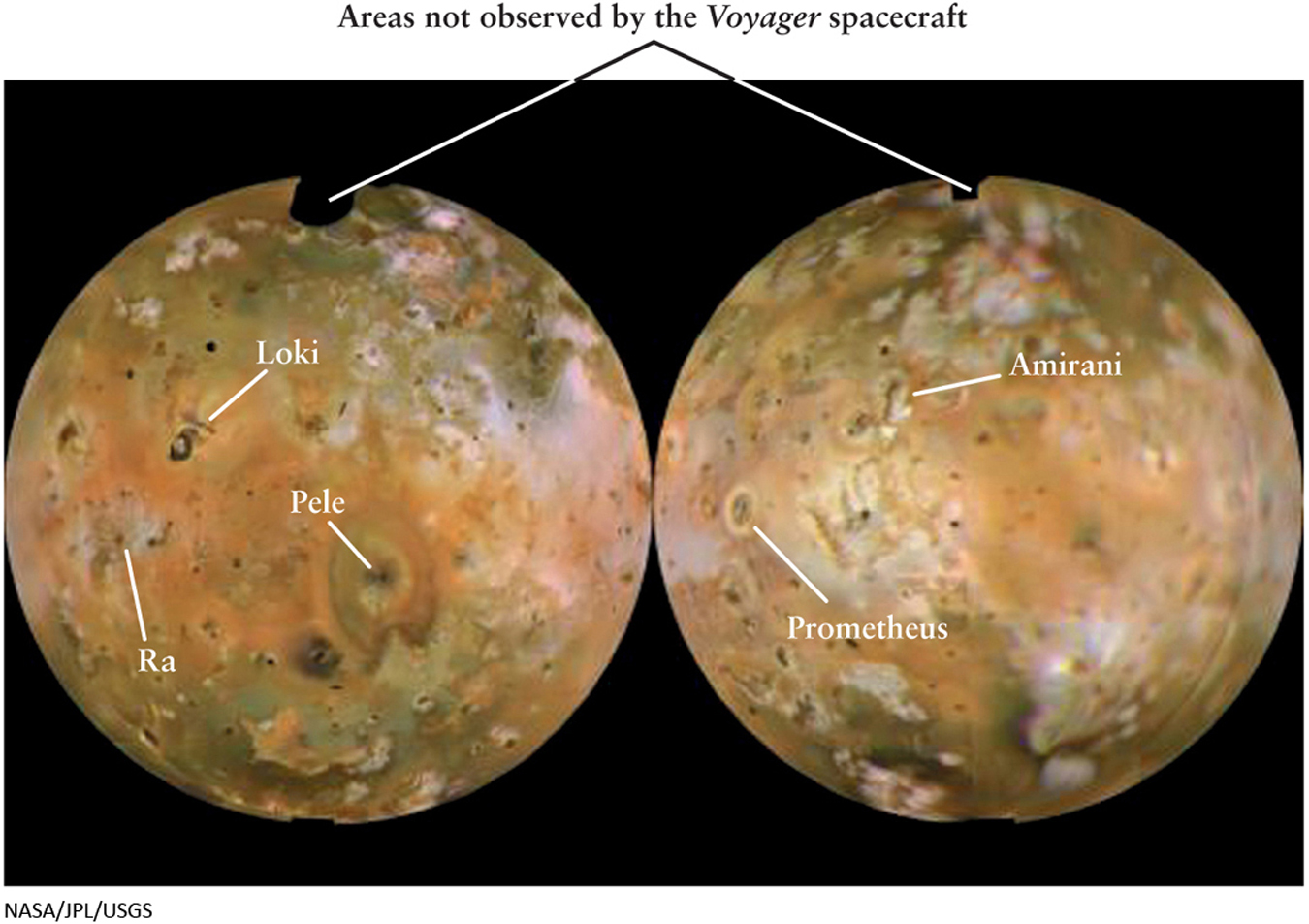
More recently, the Galileo spacecraft, which came as close as 200 km to Io’s surface during its eight years in orbit around Jupiter, returned detailed images of several volcanic plumes (Figure B6-1.2b). These plumes rise to astonishing heights of 70 km to 280 km above Io’s surface. To reach such altitudes, the material must emerge from volcanic vents with speeds between 300 m/s and 1000 m/s (700 mi/h to 2200 mi/h). Even the most violent terrestrial volcanoes have eruption speeds of only around 100 m/s (220 mi/h). Scientists began to suspect that Io’s volcanic activity must be fundamentally different from volcanism on Earth.
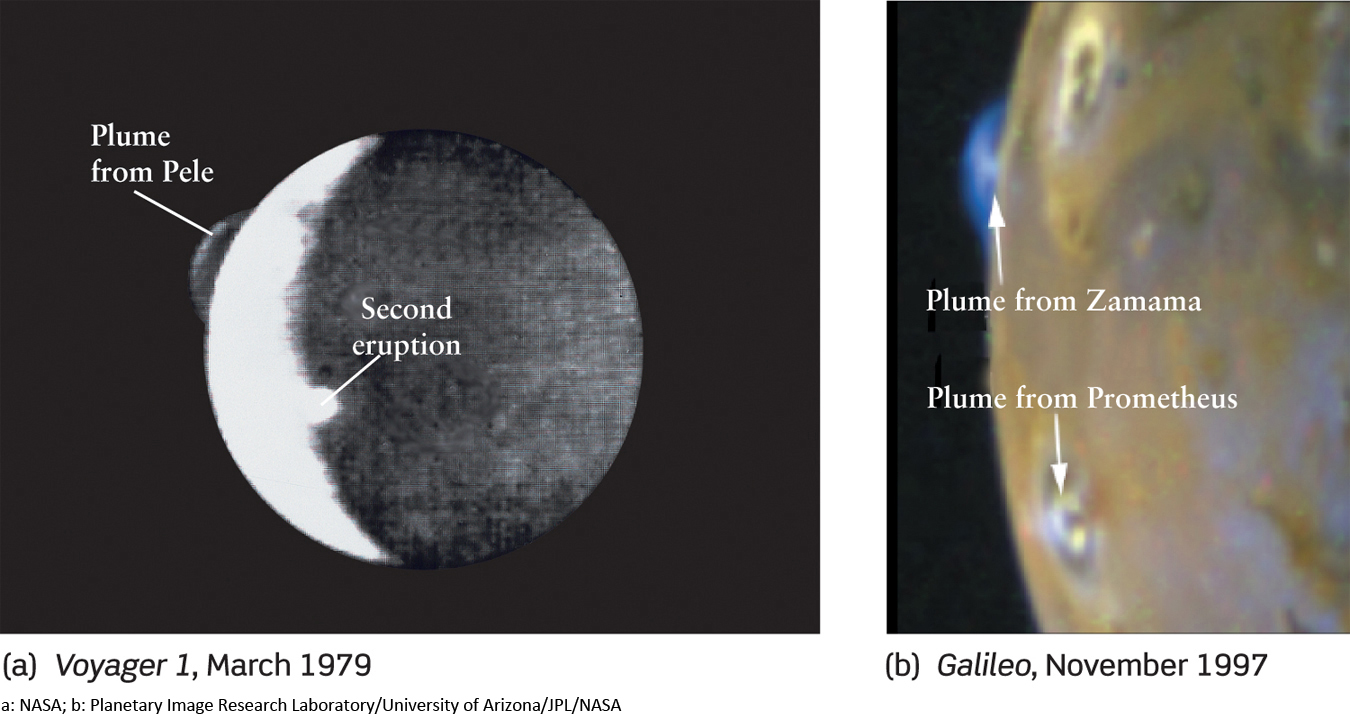
As it turns out, as Io moves around its orbit, Jupiter and its other moons exert gravitational tugs on it in a regular, rhythmic fashion, alternately squeezing and flexing the innermost moons. Just as a ball of clay or bread dough gets warm as you knead it between your fingers, this squeezing and flexing causes heating of Io’s interior. This results in unexpected, yet widespread and recurrent, surface volcanism on Io.
An important clue about how volcanoes on Io are different than volcanoes on Earth came from the infrared spectrometers aboard Voyager 1, which detected abundant sulfur and sulfur dioxide in Io’s volcanic plumes. This led researchers to suggest that the plumes are actually more like geysers than volcanic eruptions. In geysers on Earth, water seeps down to volcanically heated rocks, where it changes to steam and erupts explosively through a vent. Planetary geologists Susan Kieffer, Eugene Shoemaker, and Bradford Smith suggested that sulfur dioxide, rather than water, could be the principal propulsive agent driving volcanic plumes on Io. Sulfur dioxide is a solid at the frigid temperatures found on most of Io’s surface, but it should be molten at depths of a few kilometers. Just as the explosive conversion of water into steam produces a geyser on Earth, the conversion of liquid sulfur dioxide into a high-pressure gas could result in eruption velocities of up to 1000 m/s on Io.
Io’s dramatic coloration (see Figure B6-1.1) is probably due to sulfur and sulfur dioxide, which are ejected in volcanic plumes and later fall back to the surface. Sulfur is normally bright yellow, which explains the dominant color of Io’s surface. But if sulfur is heated and suddenly cooled, as would happen if it were ejected from a volcanic vent and allowed to fall to the surface, it can change to orange, red, or black. Indeed, these colors are commonly found around active volcanic vents (Figure B6-1.3). Whitish surface deposits (examine Figure B6-1.1 and Figure B6-1.3a), by contrast, are probably due to sulfur dioxide (SO2). Volcanic vents on Earth commonly discharge SO2 in the form of an acrid gas. But on Io, when hot SO2 gas is released by an eruption into the cold vacuum of space, it crystallizes into white snowflakes. This sulfur dioxide “snow” then falls back onto Io’s surface.
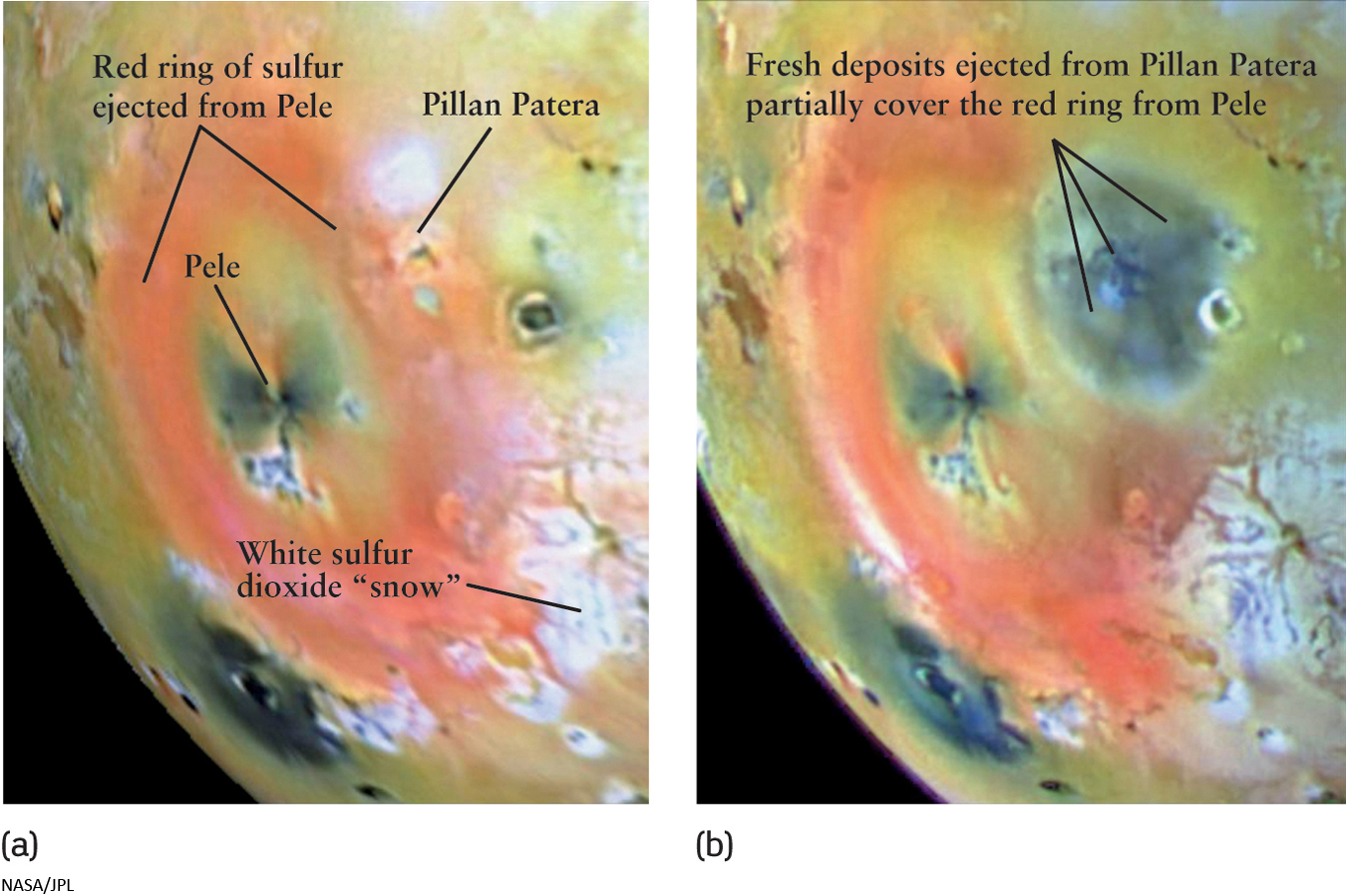
What is beneath Io’s constantly changing surface? We have never landed a spacecraft on the surface of Io, but precise measurements of Io’s gravity taken by the Galileo spacecraft demonstrate that Io’s interior has layers. Io has a relatively large and dense core surrounded by a partially molten layer enclosed by a very thin crust.
Io may have as many as 300 active volcanoes. Altogether, volcanism on Io could eject enough material to cover the entire surface of Io to a depth of 1 m in a century, or to cover an area of 1000 km2 in a few weeks (see Figure B6-1.3). Thanks to this continual “repaving” of the surface, there are probably no long-lived features on Io, and any impact craters are quickly obliterated.
About 80% of the surface of Venus is composed of flat plains of volcanic origin. In other words, essentially the entire planet is covered with lava! This observation shows the tremendous importance of volcanic activity in Venusian geology. Most of the volcanoes on Venus are probably inactive at present, just as is the case with most volcanoes on Earth. But Magellan found evidence of recent volcanic activity, some of which may be continuing today. The key to estimating the amount of recent volcanic activity is that the radar reflectivity of volcanic materials depends on whether the material is relatively fresh or relatively old. By mapping these reflectivity variations on Venus, Magellan found many areas with young lava flows. Some of the youngest material found by Magellan caps the volcano Maat Mons (see Figure 6-15a). Geologists estimate that the topmost material is no more than 10 million years old and could be much younger. The presence of such young lava flows suggests that Venus, like Earth, has some present-day volcanic activity. (Are you wondering if there are other volcanoes in the universe? See Box 6-1: Jupiter’s Moon Io Is Covered with Active Volcanoes)
153
Another piece of evidence for ongoing volcanic activity on Venus comes from the planet’s atmosphere (Section 6-4). An erupting volcano on Earth ejects substantial amounts of sulfur dioxide, sulfuric acid, and other sulfur compounds into the air. Many of these substances are highly reactive and short-lived, forming chemical compounds that become part of the planet’s surface rocks. For these substances to be relatively abundant in a planet’s atmosphere, they must be constantly replenished by new eruptions. Sulfur compounds make up about 0.015% of the Venusian atmosphere, compared to less than 0.0001% of Earth’s atmosphere. This suggests that ongoing volcanic eruptions on Venus are ejecting sulfur compounds into the atmosphere to sustain the high sulfur content.
154
COSMIC CONNECTIONS: Putting It All Together

|

|

|

|
|
|---|---|---|---|---|
| How many impact craters appear on the surface? | Heavily cratered areas and smooth low-lying plains | Only about a few thousand craters, uniformly spread across the planet’s surface | Few craters: approx. 200 | Heavily cratered in highlands; lowlands are smooth and free of craters |
| How does the size of the planet relate to the number of craters? (reference the “rule,” page 144) | This small planet quickly cooled and ceased geologic activity, so the craters remained undisturbed, indicating the surface is old. | Only slightly smaller than Earth, Venus has the internal heat to power geologic activity. Tectonic evidence, below, explains why not all craters have been erased. | Earth is large enough to retain internal heat to be geologically active. Hence, craters are “erased” and the surface is relatively young. | An intermediate size between Mercury and Earth, the once hot interior erased some craters before the interior solidified. |
| What does the evidence of tectonics tell us? | Scarps formed when the young planet cooled and contracted, but lack of evidence of lava flow around the scarps indicates the planet had already solidified to a substantial depth. There is no other evidence of tectonics. | Dramatic, but small-scale, deformations have reshaped the surface, but there are no mountain chains and there is no evidence (like Earth’s Mid-Atlantic Ridge) of plates spreading. Instead of plate tectonics, Venus undergoes “flake tectonics.” | Earth has moving plates that collide into mountain ranges, subduct back into the mantle, and create new surfaces when plates separate. | Like Venus, Mars lacks the ridges and subduction zones that plate tectonics produces. The crust is one single plate. The Martian bulge at the Tharsis rise and the rift at the Valles Marineris are indicators of ancient geologic activity. |
| What does it mean that Earth is “just right” for plate tectonics? | Mercury cooled too quickly to sustain the heat for tectonics. | Venus’s crust is one single plate and it is too thin for plate tectonics. | Earth’s crust isn’t too thin or too thick, so it’s just right for plate tectonics. | Mars’s crust is also a single plate, but it is too thick for plate tectonics. |
| What is the evidence for volcanoes? | Mercury has no evidence of volcanoes. | 80% of Venus is composed of flat plains of volcanic origin. Volcanoes would develop from a hot spot, a single place that would produce one giant volcano, rather than a chain. There may be some present-day volcanic activity. | Earth has volcanoes, primarily at the plate boundaries, where subducted material becomes molten magma and rises upward to erupt. Volcanoes may appear in chains as a plate moves over a hot spot. | Any number of immense volcanoes were active when Mars was young. Like on Venus, they formed over a single hot spot. Now all are inactive. |
155
Unlike lava flows on Venus, however, most of the lava flows on Mars have impact craters on them. This cratering indicates that most Martian lava flows are very old, and that most of the volcanoes on the red planet are no longer active. This is what we would expect from a small planet whose crust has cooled and solidified to a greater depth than that on Earth, making it difficult for magma to travel from the Martian mantle to the surface.
Cosmic Connections: Putting It All Together summarizes the surface features of the terrestrial planets.
Question
ConceptCheck 6-8: Why are there almost no craters on io when it has no plate tectonic collisions or separations actively resurfacing the landscape?
Question
ConceptCheck 6-9: How can astronomers estimate the age of a lava flow from a volcano?